

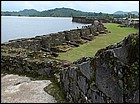
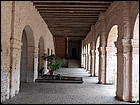

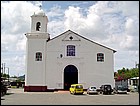
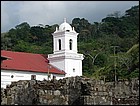
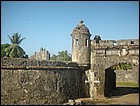


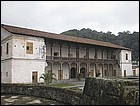
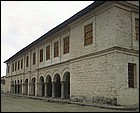



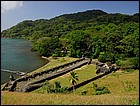

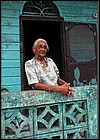


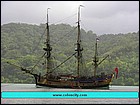

Portobelo
The quaint town of Portobelo lies 20 miles northeast of Colón (about an hour's drive from Colon) and was connected by a stone highway "El Camino Real" with Old Panama. Later on, it was accessible only by boat from Colon. It is situated in a splendid harbor which was discovered and named by Christopher Columbus when, in 1502, his vessels sought shelter in the "Portobelo" meaning "Beautiful Port" from a great storm. The town was founded in 1597 and was given the name of San Felipe de Portobelo in honor of King Phillip II of Spain. From its commercial demise when the isthmus became independent from Spain in 1821, until a few years ago, Portobelo, the Spanish Main’s richest treasure port, mouldered, a roadless fishing village with an annual flicker of life for the Black Christ celebration. Now, approached by an excellent highway, the Spanish Main, albeit time-weary, is there for all to capture single-handed.
Portobelo is one of the oldest Spanish settlements on the Caribbean coast and at one point was the center of the Spanish Main. It was through Portobelo that almost all of Spain's plunder was accounted for before being shipped back to Spain. The bay was heavily guarded by forts on both sides and was host to one of the largest annual fairs in the Americas at the time.
Portobelo was the port of entry and of exit for all of South America. The exchange of merchandise took place annually at Portobelo in the form of a fair which lasted from 30 to 60 days. During this time, this sleepy little place was a beehive of activity. Transactions frequently totaled from 10 to 12 million gold pesos. These fairs took place once each year until 1738 when, as a result of continual attacks by pirates, Spain was forced to abandon the Isthmian route for the longer but more secure one around Cape Horn. The frequent pirate attacks forced the Spaniards to adopt a convoy system. Each year two fleets of 40 to 70 ships sailed from Spain, one bound for Veracruz, the other for Portobelo. The arrival of the fleet signaled the opening of the great fair.
It was also fair game for the English pirates, like Drake and Morgan. Much of the old settlement has been overrun by the local village but there are still some good ruins and examples of the Spanish fortifications.
Portobelo suffered its first attack in 1596, even before it was officially founded, at the hands of Sir Frances Drake who died of fever before he could capture it and was secretly buried at sea off the entrance to the harbor. In 1668, Sir Henry Morgan attacked the town from the land and launched a surprise attack on Fort Santiago el Principe. He then attacked the remaining Spanish garrison, using monks and nuns to place scaling ladders against its walls. The city was at the mercy of Morgan's men who launched upon an orgy of looting, debauchery and torture. Portobelo lived through this reign of terror however. Other buccaneers and pirates who attacked Portobelo were Englishmen William Parker in 1601 and Edward Vernon in 1739.
The most interesting and historic ruins are also the ones most accessible to the visitor. The forts of Santiago and San Geronimo are each but a 5-minute walk from the pier. The forts are a neat place to explore. Cannons still point out to sea, although the munitions depots are now empty and the only permanent inhabitants of the fort are countless crabs. The forts are not massive, and there isn't a lot to see, but it's interesting to look out over the bay and realize that Sir Francis Drake, the first Englishman to circumnavigate the globe, died in Portobelo and lies buried under the silt in the sea nearby.
Even closer is the "Customs House", built in 1630, the remains of the church of La Merced, and the church of San Felipe, the last building to be built by the Spaniards. It was inaugurated in 1814. Its most carefully guarded and priceless relic is a beautifully carved statue of Jesus of Nazareth which, because of the dark wood from which it is made, is known as the "Black Christ".
Every year on the 21st of October, Portobelo relives a day of its glorious past in a celebration in honor of the Black Christ. The city is filled with people in a candlelight procession. The statue of the Black Christ is brought out of the church on a platform borne by 80 men and is carried through the streets of the city. It is followed by hundreds of pilgrims carrying candles who march behind it until it is once again restored to its resting place.
Every two years, the Festival of Diablos and Congos brings a burst of color and drama to Portobelo. Tourists and locals alike are drawn to the San Jerónimo Fort and other smaller sites in Portobelo to see the Congos, Diablos, musicians, and singers who have come from many towns and the provincial capital of Colón. The artists and performers bring their best skills and talents to the masks, the costumes, the dances, and the music that enliven the Festival. It is a spectacle not to be missed. Other complementary activities that share in the celebration of the area’s long and proud Afro-colonial heritage include a crafts fair, a farmers’ market featuring regional food and drink specialties, art and photography exhibits, and other family-friendly entertainment.
The Customs House has been restored and is a good place to see some of the history. Portobelo is also famous for it's Black Christ - kept in the church just off the main square.
With the building of the trans-Panama railroad (1848–55) and finally the digging of the Panama Canal, Portobelo declined.

